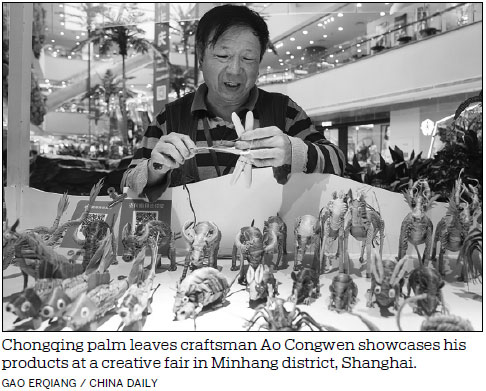Turning palm leaves into fanciful works
Seated under a tent and in front of a simple desk, Ao Congwen effortlessly weaved palm leaves into dragonflies, grasshoppers, frogs and roses, using only a pair of scissors and a fine needle.
The 62-year-old, who was showcasing his craft at a creative fair held recently in suburban Shanghai's Zhaojialou town in Minhang district, was a hit with the visitors, especially children. His simple creations sold for just 30 yuan ($4.34), while the more complex ones cost up to 160 yuan.
"The handicraft of palm fiber weaving has become an inseparable part of my life. I usually spend the whole day weaving and finding places to sell during weekends," says Ao, who has been weaving for 22 years.

Born and raised in southwestern China's Chongqing city, Ao recalls that he was first fascinated by the craft about 20 years ago when he chanced upon a craftsman weaving by the roadside.
"I was eager to acquire the craft but couldn't afford to do so because my family was in debt at that time," says Ao, who had some experience in weaving when he was a child.
"I learned it by observing him (the craftsman) from a distance. Luckily, I learned some basic techniques after three days of observation. It took me almost a year to completely master the craft."
According to Ao, the craft of palm fiber weaving can be divided into two types. The first, which withers quickly, is made of fresh palm leaves with a bright color. The other type, which can be preserved for decades, is made up of dried leaves.
Ao said that he would go to the countryside and collect the material for his creation, carefully picking fresh palm leaves that are long and wide before drying them in the sun.
"The 12 Chinese zodiac signs are my favorites. The complicated ones, like the dragon, usually take me one or two days to accomplish," he says.
"I frequently collect new weaving patterns online as useful references and try to explore ways to create them. We need to be innovative in order to take the craft to a new height."
The craft of palm fiber weaving, which originated in the Three Kingdoms (220-280), has a history that spans more than 1,700 years. It was listed as a national intangible cultural heritage by the State Council in 2011.
Today, Ao is among the few people who are still relying on the craft to make a living. Guo Jing, a researcher at East China Normal University who focuses on the protection of intangible cultural heritage, said that many traditional handicrafts such as palm fiber weaving are dying because "there are too many things that keep people entertained nowadays". Apart from the handful of representative inheritors of intangible cultural heritage, most craftsmen find it difficult to make a living from traditional art.
As such, creative fairs, workshops and handicraft studios have been playing an important role in introducing these traditional skills to the masses as they allow people to try the craft out for themselves, adds Guo.
"I once had an apprentice who showed great interest in the craft, but he eventually gave up. It is hard for people, especially the young, to have the patience to pursue crafts that take up so much time and energy," says Ao, who has resorted to selling marshmallows while displaying his handicrafts.
"The weaving craft is not a profitable business. Though many people are fascinated with the craft the moment they see it, few choose to buy. Besides, we have to pay for the site and that makes our business rather difficult. We hope more exhibition sites can be provided for folk artists to expand their influence."
Tang Xiaofan contributed to this story.
(China Daily Global 05/24/2019 page15)


















